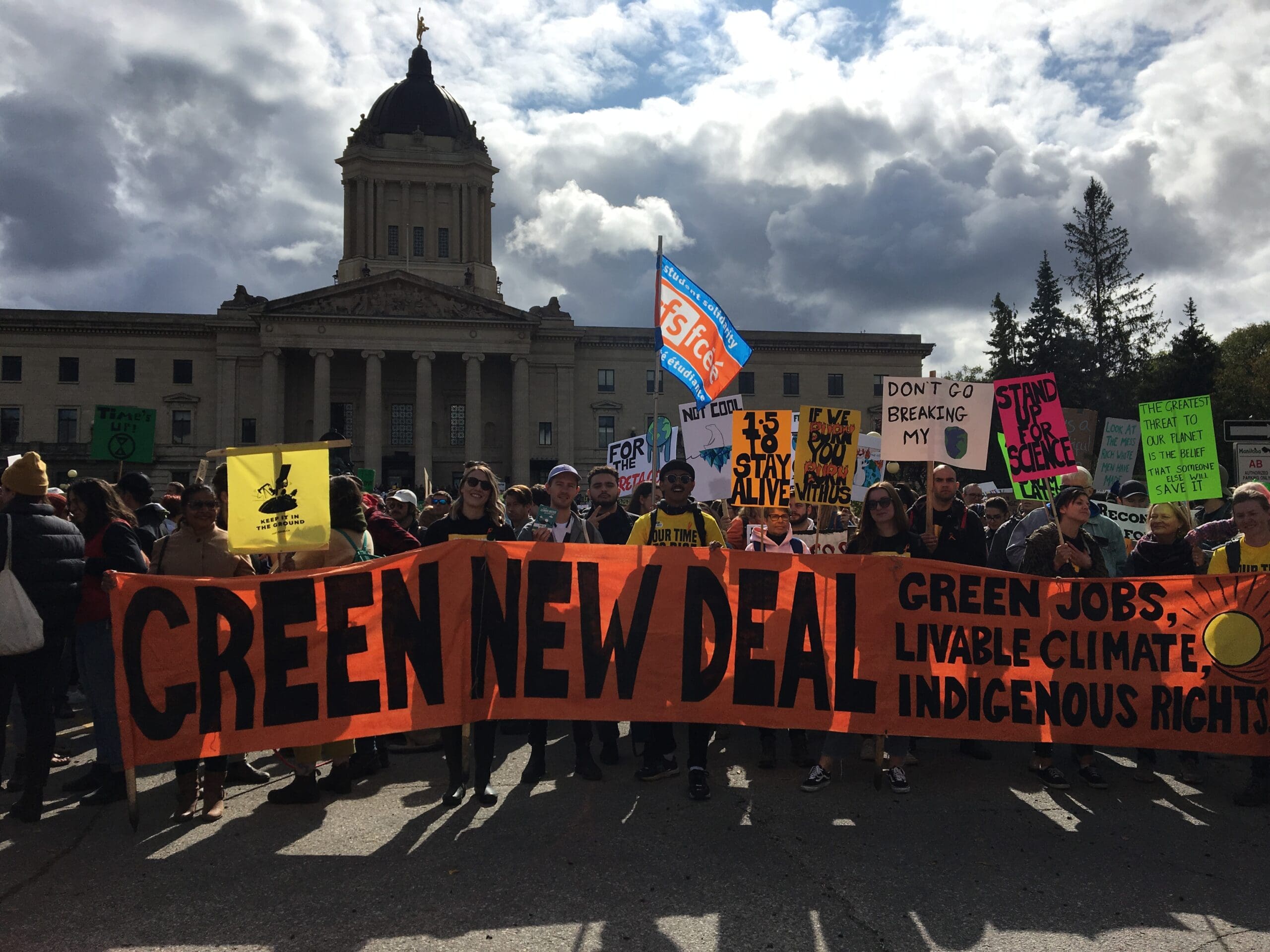The youth-led climate movement is intent on passing Green New Deal legislation this year despite organizing and political challenges.

Our Time at the September 27 Global Climate Strike (photo by Laura Cameron)
Hope for action on climate is in the hands of mass movements. Through the student climate strikes (Climate Strike Canada) and Our Time (for a Green New Deal), young climate activists are mobilizing people of all ages and pushing governments to legislate the large-scale response needed to get to net zero greenhouse gas emissions by 2050.
A minority Liberal government creates potential for bolder climate action with support from the NDP and Greens, while conservative-led provinces are bound to push back no matter what the federal government proposes. It’s incumbent on us, in this political moment, to reject half-measures and push for the most expansive and inclusive just transition possible.
It’s time for us to get behind what people around the world are calling a Green New Deal.
As a framework for climate legislation, the Green New Deal arose in response to the environmental wreckage and growing inequality that are a direct product of fossil-fuelled capitalism. The only way to meet our climate obligations is to transform our economy—not just away from fossil fuels but also to be more equitable and inclusive.
The GND therefore combines financial help for transitioning energy workers with secure universal pensions for all, good quality housing, high-wage job creation, expanded public services (health care, child care, elder care, and transit), restored public and natural spaces, and a new internationalism based on solidarity and true development. Absolutely central to the Canadian Green New Deal movement is decolonization and Indigenous rights.
“We will not achieve climate justice without Indigenous human rights. UNDRIP and the right to free and informed prior consent are central to our struggle,” says Leah Gazan, newly elected NDP MP for Winnipeg Centre, and one of Our Time’s Green New Deal champions.
The social policy piece of the GND is crucial for two reasons. First, making a job guarantee and expansion of public services part of our demands is how we build support for the mass movement we need to make this happen. Second, an economy centered on care work, along with sustainable food production, housing, and transportation, is what a low-carbon economy looks like.
The challenge will be convincing enough Canadians that dismantling fossil fuel capitalism is in the interests of all. Those whose futures are being stolen by inaction understand this clearly, which explains why they are leading the way toward a Green New Deal.
Diversity of tactics
The national youth-led movement Our Time emerged out of 350.org’s 2019 conference, Powershift: Young and Rising, and the Winnipeg Hub began organizing around a Green New Deal last spring. If the focus was on national politics and the election, it’s because only the federal government has the heft to bring in the sweeping measures—sometimes compared to an all-out war mobilization—needed to respond meaningfully to the climate emergency.
Many young people were and still are hesitant to engage in electoral organizing due to an erosion of faith in our democratic processes. Some have overcome this to do lobbying work with Our Time, while others choose to focus on education and community capacity-building, and planning local “Fridays for the Future” climate strikes. But as one activist explained, “We need everyone doing everything all the time.” With its diversity of tactics, the climate movement is attracting hundreds of people new to organizing or new to the climate action movement.
“There is tremendous potential here,” says David Camfield, professor of sociology and labour studies at the University of Manitoba and activist member of Manitoba Energy Justice Coalition (MEJC), a supporter of the Manitoba Youth for Climate Action’s September 27 Global Climate Strike in Winnipeg. “The climate strike drew in tonnes of people. Some have organizing skills and others are new to social movements. The challenge is for leaders to facilitate everyone finding a role to play.”
As reported recently in the Monitor (September/October 2019), Our Time held town halls last spring with the Pact for a Green New Deal and hosted the Leap tour in June. Organizers collected almost 50,000 signatures asking CBC to host a fall election leaders’ debate on the climate crisis and held over 30 rallies outside CBC headquarters in Winnipeg, Ottawa, Toronto, Vancouver, Whitehorse, Yellowknife, and other communities. CBC rejected the idea, saying the climate would be covered in the general all-candidates debate. On October 10, during the final debate of the election, the greatest emergency of our time got 21 minutes.
As the election drew nearer, Our Time hubs started meeting with candidates face to face to determine whether we could count on them to support a Green New Deal if elected. In Winnipeg, Our Time approached and then chose to endorse Leah Gazan, a fierce Indigenous rights advocate running for the NDP who became one of the faces of the national Our Time campaign.
“I was really honoured to be supported by the Our Time campaign and I’ve been pushing Our Time at every opportunity,” she says. “It’s important to recognize youth…are on the frontline of the climate emergency. They’ve asked for very reasonable things—healthy land, healthy food, clean water, and clean air…. But [the Liberal government is] really focused on building a pipeline. Canada has one of the worst climate plans of all G7 countries. We are the least likely to meet climate targets.”
Of the 35 candidates endorsed by Our Time, eight (including Gazan) were elected: Niki Ashton for Churchill–Keewatinook Aski (MB), Daniel Blaikie for Elmwood–Transcona (MB), Alexandre Boulerice for Rosemont–La Petite-Patrie (QC), Don Davies for Vancouver–Kingsway (BC), Peter Julian for New Westminster–Burnaby (BC), Matthew Green for Hamilton Centre (ON), and Jenny Kwan for Vancouver East (BC).
On election night, Gazan announced: “Our campaign was a testament to the power of a grassroots political movement. It was fuelled by people. It was funded by people. I think it shows the power of people and how that is going to lead to change in this country.”
After the election
The first few weeks are critical for influencing the course of the new government. On October 28, Our Time organizers from Ottawa, Toronto, and Montreal occupied the House of Commons to call for immediate climate action and a Green New Deal. Twenty-seven Our Time activists were arrested for this action, receiving tickets for trespassing and a one-month ban from Parliament Hill. Several MPs, including NDP leader Jagmeet Singh, later tweeted their support.
In the following days, we reached out to all 338 MPs to deliver a mandate letter calling for a public pledge to make a Green New Deal a top priority when the House resumes. When the Monitor went to print, 17 had accepted the pledge. New Westminster–Burnaby MP Peter Julian filed a GND private member’s bill in the House of Commons in December.
Separate from these political moves, non-governmental member organizations of the Pact for a Green New Deal will release their plan in early 2020. Importantly, it will be based on the priorities of the 150 communities visited during last year’s GND tour, and emphasize the needs of Indigenous, low-income, newcomer, racialized, and young people. The last thing we need is for the language and spirit of the Green New Deal to be co-opted to appease calls from the Alberta and Saskatchewan governments for more pipelines and corporate handouts for the fossil fuel industry.
“Jason Kenny had a “I love Oil and Gas” jersey on at the Grey Cup. People don’t love oil and gas, they love working, working themselves out of poverty, having a roof over their head,” says Gazan. “We need to change the rhetoric from an ‘oil and gas’ issue to ‘I need to have a job’ issue.”
What’s next
The latest UN assessment gives us a mere decade to hold global temperature increases to less than 1.5 degrees Celsius. According to Camfield, the movement should prioritize finding a consensus on what climate justice means and how to achieve it in this urgent political context. “We need a strategy of escalation to exert power on the federal government for what’s needed,” he says.
Students continue to organize “Fridays for the Future” climate strikes. A strike in Winnipeg on November 29 included a round dance organized by Idle No More activists, as well as a clothing swap. A global follow-up to the millions-strong September 27 climate rally is planned for the spring.
Here in Winnipeg, Our Time and the CCPA-Manitoba recognize the need to build stronger relationships with the Indigenous community and beyond. We know that any struggle for a Green New Deal must take direction from those who are most dispossessed by fossil capitalism and most exposed to climate change. We do not wish to reproduce in our organizing spaces the undemocratic relationships of exploitation that have gotten us to this point. We need to unlearn the oppressive practices we frequently deploy, often unconsciously, even when our hearts are in the right place.
There is a lot of pressure to act now, but building relationships and trust takes time, as does learning new skills. With that in mind, several Our Time–Winnipeg organizers recently participated in a direct action training session organized by the Indigenous youth–led Strawberry Heart Protectors and the Indigenous Peoples Power Project.
“We need the grassroots and electoral politics,” says Gazan. “Politicians say, ‘How are we going to get re-elected?’ It is by people, and we forget how powerful we are. People actually have identified common problems, and common solutions. It’s how are we going to get there that sometimes differs. We can move it if we mobilize people and lift up people’s voices.”
Hannah Muhajarine is an organizer with Our Time. Molly McCracken is Director of the Canadian Centre for Policy Alternatives–Manitoba.


